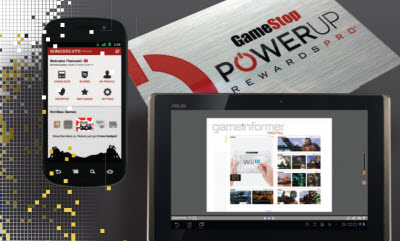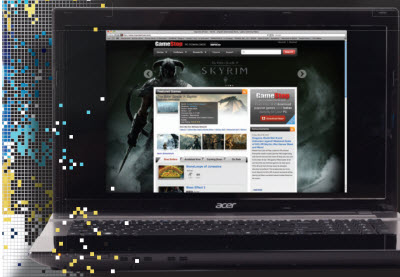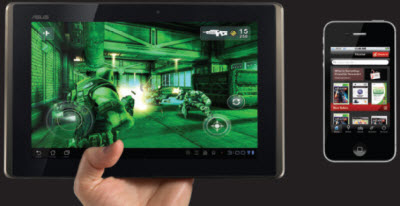 GamesBeat: So when you see something like Ouya, for example — it just popped up yesterday [July 9]. Something like that doesn’t really scare you?
GamesBeat: So when you see something like Ouya, for example — it just popped up yesterday [July 9]. Something like that doesn’t really scare you?
Petrovic: No, we embrace it. As the panel said earlier, that’s clearly a validation of a certain segment of the market that thinks that it’s interesting. There have been many consoles, as many of you know much better than I can, that have come and gone in the past, as well as some that exist today in a more niche manner. OnLive is a great example of one. I think they’ve created a wonderful product. Ultimately, if there’s consumer demand before it, we’ll look at embracing it as best we can.
GamesBeat: Let’s switch directions for a bit. For new publishers and developers — we have a lot of new gamemakers in the audience — what are the pros and cons, from your perspective, to physical media versus digital?
Petrovic: That’s a pretty loaded question. The promise of creating content in digital form has always been the opportunity to reach the consumer directly. I think the market has found, with varying degrees of success and failure, that ultimately you’re still beholden to a gatekeeper. Whether on the physical side, that’s Microsoft, Sony, Nintendo, or whether on the digital side, that’s Apple, Google Play, Facebook…you always have somebody there that stands in between you and the consumer. I think that’s forced a lot of folks to think about how we can do an end-around.
Not so much on the mobile side because it’s very weighted on the operating system, but on the web. How can you go direct? But then it becomes a marketing line-item on your P&L. How do I effectively garner my own audience starting from zero? Physical media has the tried-and-true formula that has worked for a long time, albeit very focused on tentpole IP. It very much mirrors the movie industry these days. But still, you compare. Rovio is one of the more prolific brands in this new generation of gaming, having done 70 million of their 100 million dollars last year from their game. And then you compare that to Call of Duty, which I think did that in two minutes? From a scale perspective, there’s still somewhat of a difference. But definitely, digital makes things more efficient.
GamesBeat: All of us here are from Silicon Valley. We’re in the business, we’re here covering gaming, or we’re making games. We might have a skewed perspective on what consumers think. We think, OK, digital is the future, and retail’s dead. But we forget about the average consumer in the Midwest who’s walking into a store. Ouya’s still a foreign concept to them. They don’t understand what Gaikai’s about. Can you talk more about this consumer? So we don’t forget about that there are a lot of Americans out there who are still buying games in traditional ways.
Petrovic: It’s a good point, and it’s something I was somewhat ignorant to when I came into this job in 2009, because I’ve lived most of my life on the Internet since the late ’90s, both on the West Coast and the East Coast. GameStop has a global footprint in over a dozen countries. What you realize is with certain rare exceptions like where we’re sitting today, the majority of users are not digital.
There’s a huge delta between early adopters and the mass market. I think it’s much larger than any of us are willing to acknowledge sometimes because it just isn’t a fun story. I was sharing with you earlier a statistic. When I came on board with the company, I believe almost 50 percent of our used game sales were for the PS2. This was in 2009, 2010, somewhere in there. That was a mind-boggling stat for me, when you think about a platform that first came out however many years before I joined, and it was still accounting for the majority of used game sales.
You think about how much longer people hold on to their stuff that they’ve invested a lot of money in. You realize that folks are value-oriented. Folks are not like us, necessarily, the ones waiting in line to get things on day one. They have kids at home; they don’t want to spend as much money as a new product would cost. They’re happy to spend after it’s come down a little bit or after it’s a few years old, whether it’s a game or a console. It was eye-opening to me to go into the Midwest and go into the Southeast and see that behavior that’s fundamentally at a much slower cadence than how we’re operating here.
 GamesBeat: For today, our description of this fireside chat was “How can traditional retail evolve to meet the needs of its customers, and how can retail leverage direct relationships with customers into a billion-dollar digital business?”
GamesBeat: For today, our description of this fireside chat was “How can traditional retail evolve to meet the needs of its customers, and how can retail leverage direct relationships with customers into a billion-dollar digital business?”
You kind of touched on that a little bit. But it’s a little bit vague. Can you give us more specific details about what you’re working on and why you feel GameStop is still evolving into the future and can be a part of consumers’ spending habits?
Petrovic: I think it’s a combination of knowing the consumer and having access to those consumers on behalf of the game developers who want to reach them. We have digital platforms like Kongregate, which continues to be a fast-growing social gaming platform.
We have a ton of cases of these games that have come on there either after Facebook or to the exclusion of Facebook that are doing as well, if not better on that platform, even though we have a fraction of the audience. The thesis behind that acquisition was that it’s an authentic gaming platform that has social elements, but it’s first and foremost about gaming, which is the reverse of how Facebook is. I think we announced yesterday that 5th Planet Games is launching exclusively on Kongregate. Spicy Horse, from Shanghai, gave us their game exclusively, and we’re getting a lot more of those kinds of things. We leverage the power of the GameStop global footprint to promote and market these games. We’re driving a lot of our users to those games.
Another data point is, our users convert probably eight to 10 times higher than inbound organic users to that game. So we have a very valuable audience. We have a loyalty membership — many of you are probably members of it — it’s a points-based system called PowerUp Rewards that’s 18 million people and growing. They represent about 30 to 35 percent of all video game consumption in the U.S. So when you talk about the whales of gaming, there are the whales, in my mind, with a lowercase “w,” where you talk about somebody who’s maybe spending about $15 or $20, lifetime value. And then there are folks who make up the majority of our U.S. revenues, that are spending hundreds if not thousands of dollars annually on all sorts of gaming with us, whether it’s console, PC, social gaming on Kongregate, or on other platforms, and also on mobile.
So we feel like we capture a lot of that data in terms of their game-buying, game-downloading, and gameplay habits, and we’re able to build a very robust view into that and then open up that to the development community that wants access to that. Whether it’s on the digital side, or also the power of actually having something in a retail store and having it promoted and then sending you back to your mobile phone or the web to actually access that game.
GamesBeat: You have relationships with the big publishers, the Activisions and EAs of the world, but for an indie developer who maybe doesn’t have a publisher, doesn’t have these distribution means, can those guys work with GameStop?
Petrovic: Absolutely. Kongregate, as you guys probably know, has a heritage of being very indie-focused. So a lot of the free-to-play, grassroots games that are looking for distribution go there. We have a digital distribution platform for PC games, both paid and free-to-play, called Impulse, that we bought. It’s very indie-friendly. We bought it from an indie developer, actually, called Stardock, that basically created it for their own games, much like the Steam model. That’s a very indie-friendly ecosystem. With the mobile gaming initiatives that we have, both from building a discovery platform that’s a work in progress, as well as the game controller that we built, we partnered with about half a dozen indie developers to make their games controller-friendly, and we preloaded those games onto the Android tablets that we sell. So we’re very active in trying to also embrace that very important community that is the future of game content.
GamesBeat: Speaking of Impulse, Steam and Impulse are pretty comparable for us on the surface. But it’s not something that comes up very often. I guess some people aren’t aware of it. But for example, yesterday we had an indie game panel, and we asked the panelists what were their favorite distribution platforms, favorite systems? It was almost unanimously Steam. Steam is very friendly. What can Impulse do to try to compete with Steam?
 Petrovic: I think as much as we may view that as a competitive platform, we also embrace Steam, as many of you know. We sell games that have Steam integrated into them, and we announced a partnership recently with Valve to sell Steam cards in our stores. So ultimately, we want to be very consumer-friendly in servicing them, whether they want to play a game on Steam, or whether they want to be independent of Steam and have something that’s a little less locked-in.
Petrovic: I think as much as we may view that as a competitive platform, we also embrace Steam, as many of you know. We sell games that have Steam integrated into them, and we announced a partnership recently with Valve to sell Steam cards in our stores. So ultimately, we want to be very consumer-friendly in servicing them, whether they want to play a game on Steam, or whether they want to be independent of Steam and have something that’s a little less locked-in.
We also sell Origin games, as well. For us, as much as we may have a platform that also distributes PC games, we see that as complementary to the larger kind of consumer-oriented vision that we have. Actually providing them with what they want, when they want it. If they’re a customer of a certain platform, we want to make sure we serve that, as well. So we’ve seen over 100 percent growth in the Impulse business, quarter over quarter, so we’re getting a lot of good traction there. The fact that we can actually sell a digital PC game in the store through a code-based mechanism — which basically means we’re never out of stock, that’s kind of our message — makes it an interesting way to garner the foot traffic that pure plays can’t because they just don’t have that. When you have half a billion people coming into your stores every day, that’s valuable real estate that you can expose developers through.
GamesBeat: Going back to Kongregate quickly, how is that positioned for you?
Petrovic: It’s doing great. They’ve doubled their size and their revenue every year since we bought them. I think this part quarter was about 150 percent growth on the free-to-play side of the business. And like I mentioned earlier, we’re getting a lot of inbound interest from…if we were standing here last year talking, I think last year for me was the year of the “core game social developer.” Going after that audience on Facebook that they felt was just untapped.
GamesBeat: So Kongregate makes a lot of its money through microtransactions. Looking to the future, do you see more opportunity in revenue from microtransactions or more from straight digital game sales?
Petrovic: Yeah, I’d say it’s a good healthy mix. Whether it’s microtransactions that happen through our own channels, like Kongregate or Impulse, or whether we’re selling currency cards, which is a huge part of our digital business, or we’re selling console DLC, which today is a fixed price point but tomorrow could evolve into smaller price points or even a whole different model altogether. We are just ultimately about being a trusted destination where consumers can discover and pay for and play games, whether we’re sending them somewhere else or whether we’re sending them on to one of our platforms. We’re kind of agnostic that way. I think what we’ve done so far…to go from zero to half a billion, and then in two years reach a billion and a half dollars, for a company of our size and perception as an old-school retailer…it’s been because of our senior management’s willingness to embrace and support new business models and new platforms.
[Photo credit: Michael O’Donnell; Image credits: GameStop annual report]
VentureBeat's mission is to be a digital town square for technical decision-makers to gain knowledge about transformative enterprise technology and transact. Learn More
